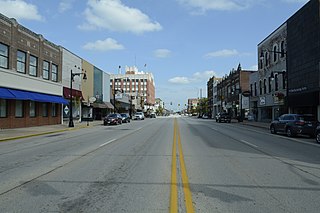
Galesburg is a city in Knox County, Illinois, United States. The city is 45 miles (72 km) northwest of Peoria. At the 2010 census, its population was 32,195. It is the county seat of Knox County and the principal city of the Galesburg Micropolitan Statistical Area, which includes all of Knox and Warren counties.
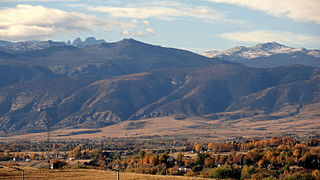
Sheridan is a town in the U.S. state of Wyoming and the county seat of Sheridan County. The town is located halfway between Yellowstone Park and Mount Rushmore by U.S. Route 14 and 16. It is the principal town of the Sheridan, Wyoming, Micropolitan Statistical Area which encompasses all of Sheridan County. The 2010 census put the town's population at 17,444 and the Sheridan, Wyoming, Micropolitan Statistical Area at 29,116, making it the 421st-most populous micropolitan area in the United States.

William Frederick Cody, known as Buffalo Bill, was an American soldier, bison hunter, and showman. He was born in Le Claire, Iowa Territory, but he lived for several years in his father's hometown in modern-day Mississauga, Ontario, Canada, before the family returned to the Midwest and settled in the Kansas Territory.

The Chicago, Burlington and Quincy Railroad was a railroad that operated in the Midwestern United States. Commonly referred to as the Burlington Route, the Burlington, or as the Q, it operated extensive trackage in the states of Colorado, Illinois, Iowa, Missouri, Nebraska, Wisconsin, Wyoming, and also in Texas through subsidiaries Colorado and Southern Railway, Fort Worth and Denver Railway, and Burlington-Rock Island Railroad. Its primary connections included Chicago, Minneapolis–Saint Paul, St. Louis, Kansas City, and Denver. Because of this extensive trackage in the midwest and mountain states, the railroad used the advertising slogans "Everywhere West", "Way of the Zephyrs", and "The Way West".

Buffalo Bill Cody Scenic Byway is in the U.S. state of Wyoming and spans most of the distance from Cody, Wyoming to Yellowstone National Park. The 27.5-mile (44.3 km) scenic highway follows the north fork of the Shoshone River through the Wapiti Valley to Sylvan Pass and the eastern entrance to Yellowstone. Most of the scenic byway is contained within Shoshone National Forest and is also known as US Highway 14 (US 14), US 16 and US 20.
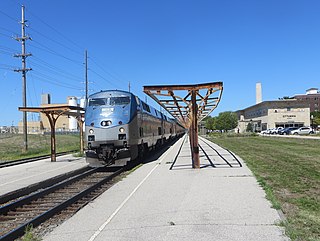
Ottumwa station is an Amtrak intercity train station in Ottumwa, Iowa, United States. The station was originally built by the Chicago, Burlington and Quincy Railroad, and has been listed as Burlington Depot by the National Register of Historic Places since November 26, 2008. It became a contributing property in the Historic Railroad District in 2011.

The Batavia Depot Museum is a museum in Batavia, Illinois that was once the town's primary train station. It was the first of many depots built by the Chicago, Burlington and Quincy Railroad. It was listed on the National Register of Historic Places in 1979 as the Chicago, Burlington, and Quincy Railroad Depot.

The Sheridan Inn is a historic hotel in Sheridan, Wyoming. Designed by the architect Thomas R. Kimball of Omaha, Nebraska in 1893, it was constructed by the Chicago, Burlington, and Quincy Railroad as part of its development program in Wyoming associated with extension of the railway. Equipped with the first bathtubs and electric lights in that part of Wyoming, the inn was considered the "finest hotel" between Chicago and San Francisco. It was declared a National Historic Landmark in 1964.

The Chicago, Milwaukee, St. Paul and Pacific Freight House, known locally as The Freight House, is a historic building in Downtown Davenport, Iowa, United States. It was listed on the National Register of Historic Places in 1985.

Buffalo Bill – The Scout is a bronze statue of a mounted rider outside the Buffalo Bill Historical Center in Cody, Wyoming, United States, that was placed in 1924 to commemorate the town's most famous resident and de facto founder, Buffalo Bill Cody. Originally in open land on the western outskirts of Cody, the statue now stands at the end of Sheridan Avenue, which became the town's main thoroughfare as Cody grew to the west. The project was initiated by Buffalo Bill Cody's niece, Mary Jester Allen, who had established the basis of what would become the Buffalo Bill Historical Center. A New Yorker, she persuaded heiress and artist Gertrude Vanderbilt Whitney to sculpt the piece.
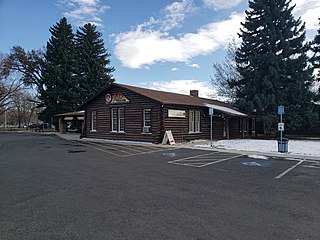
The Stock Center in Cody, Wyoming, United States, was built in 1927 as the original home of the Buffalo Bill Museum, serving in that purpose until the museum was relocated to a new complex across the street in 1969. The log structure is intended to suggest a stockman's log cabin, rendered on a large scale.
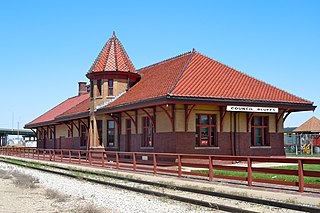
RailsWest Railroad Museum is a railroad museum operated by the Historical Society of Pottawattamie County at 16th Avenue and South Main Street and illustrates the history of railroads in Council Bluffs, Iowa.

The Buffalo Bill Cody Homestead is the boyhood home of Buffalo Bill Cody, a government scout and Wild West showman. The homestead is located in the broad valley of the Wapsipinicon River Valley south of McCausland, Iowa, United States, in rural Scott County. The farmhouse was built in 1847 by Isaac Cody, Buffalo Bill's father, of native limestone and contains walnut floors and trim.

The Two Brothers Roundhouse, formerly the Walter Payton Roundhouse, America's Historical Roundhouse, and Chicago, Burlington, & Quincy Roundhouse and Locomotive Shop is a historic building converted to a restaurant in Aurora, Illinois. It was originally constructed in 1856 as a roundhouse for the Chicago & Aurora Railroad and served in this capacity until 1974. It was abandoned until 1995, when a group of investors led by Walter Payton purchased it and converted the building to an entertainment complex. Its most recent tenant is Two Brothers Brewing. The building is the oldest limestone roundhouse in the United States and is listed on the National Register of Historic Places.

Wyoming was a Chicago, Burlington and Quincy Railroad station in Wyoming, Illinois. Now the headquarters of the Rock Island Trail State Park, the building is listed on the National Register of Historic Places as the Chicago, Burlington & Quincy Railroad Depot. The station has also been restored to the original red color.
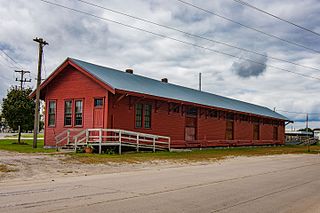
Chariton freight station is an historic building located in Chariton, Iowa, United States. Chariton was a wholesale and distribution center for southern Iowa when the Chicago, Burlington, and Quincy Railroad built the freight house in 1904. It reflected the town's importance as a division point for the railroad. The structure contains 3,700 square feet (340 m2) of interior space. The depot was listed on the National Register of Historic Places in 2003 as the Chicago, Burlington, and Quincy Freight House-Chariton.

Chicago, Burlington Northern and Quincy Depot, also known as the Red Oak Burlington Northern Depot and WWII Memorial Museum, is a historic train depot located in Red Oak, Iowa, United States. The city of Red Oak was established by the Burlington and Missouri River Railroad as Red Oak Junction. That railroad was acquired by the Chicago, Burlington and Quincy Railroad, and they laid out a new right-of-way in southwest Iowa in the late 19th century to lessen the grade. It required a new depot in Red Oak, which was built from 1900 to 1903.

Creston station is an Amtrak intercity train station in Creston, Iowa. The station is served by the Chicago–San Francisco Bay Area California Zephyr. Constructed by the Chicago, Burlington and Quincy Railroad (CB&Q) and opened in 1899, the station is listed on the National Register of Historic Places as the Chicago, Burlington and Quincy Railroad-Creston Station. Amtrak moved to the historic station in 2019 from a small station immediately to its east that had been used since 1969. Creston station is also used by the city of Creston as a city hall and community center, known as the Creston Municipal Complex.




















